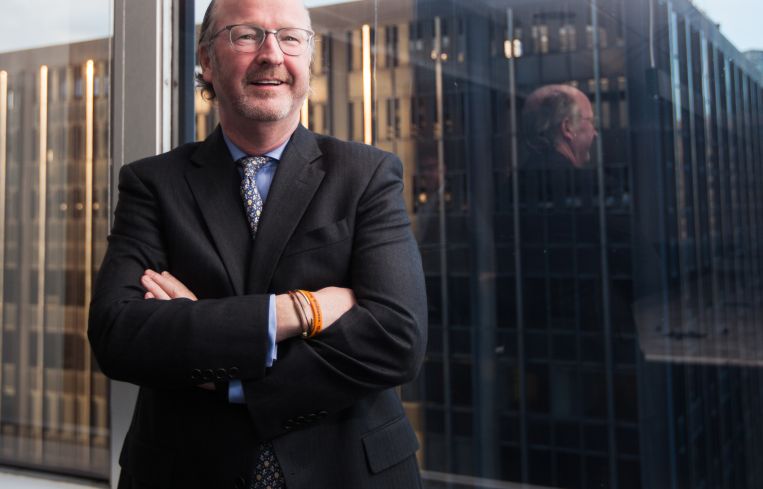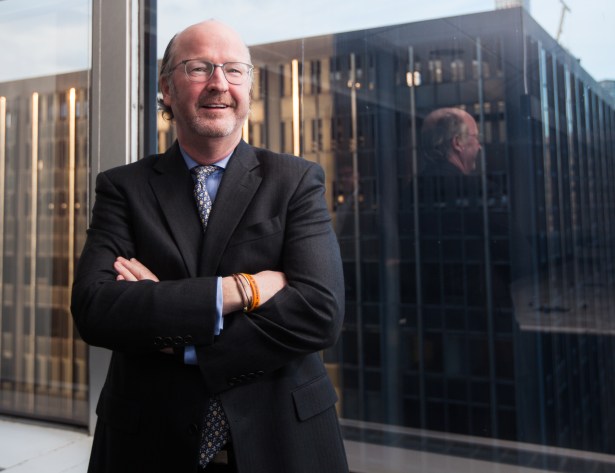Peter Hennessy on the Next Step For DTZ


What happens when a mid-sized, nationally renowned real estate services company gets acquired by a bigger, international real estate company?
That was the natural question that we had when it was announced late last year that the finishing touches were being put on the deal that had Cassidy Turley (the national real estate firm in question) being swallowed up by the even bigger property services firm DTZ.
The details were intriguing. The price of the acquisition was mammoth ($557 million, according to The Real Deal, but nobody at DTZ would confirm). And it seemed to a lot of insiders that DTZ was poised for something big on the national and international scene.
Naturally, we went to Peter Hennessy, the tri-state president of Cassidy Turley (the New York office), for an answer.
The 54-year old, Connecticut-born Mr. Hennessy seems an unlikely real estate baron. Jovial and entertaining, he alternates between regaling us with a few slick business plays and kvelling over photos of his twin 16-year-old sons. (“They are my best friends,” Mr. Hennessy said. “I’m not sure I’m their best friend.”) He talked about his previous career in advertising, and a life outside the office filled with bagels and Sunday newspapers. His office wall is sullied with magic marker scratching of things he needs to do. Unlike some of his more tight-lipped peers, Mr. Hennessy seemed delighted to tell us the inside story on the merger, and what it means for the giant going forward.
Commercial Observer: We’d like to hear about the story of the deal.
Peter Hennessy: So I’m going to start back five years ago. When we started putting together the Cassidy Turley organization what we found was that there were truly only [two] players, both domestic and globally. JLL and CBRE were the only two integrated, effective, developed platforms in the U.S. and globally. We knew that to really get [us to the next] level—meaning an international platform—[we could] stitch together businesses out of Asia, Europe, Africa, the Middle East, [but that] would take years, lots and lots of capital, and would be terribly inefficient. So we sat back and said, “How could we do this?” We needed the capital base. We spent some time speaking with all of the major service providers in the industry; we had dialogue with CBRE, with JLL, with Cushman, with DPZ, all the big players. We figured out [UGL was going to spin DTZ off] in April of 2013, so we sat back and waited. They went to a bidding process. So the private equity businesses approached Cassidy Turley. We said no [at first]. The reason we said no was we don’t go with one horse when that horse might not win. Second, whatever the winning horse is, they’re coming back to our barn. Right?
That makes sense.
They came back; TPG [Capital] came back with Brett White [former CEO of CBRE] in tow. To get him I think is a huge, huge coup for us. He’s going to be the executive chairman so he’s not going to be day-to-day, finger on the business.
What is your role now?
I continue to run the entire tri-state region.
And what is the next piece of your strategy?
The easy part is what we’ve already accomplished. Now the hard part is we want to be perceived as one of the three biggest global players but we don’t want to be perceived like the other two. So when clients are seeking out somebody to support their business—whether it’s on the occupier or the investment side—and they want one of the three players, they’re going to be comparing two apples and an orange. From the backgrounds our leadership team come from—whether it’s Marla Maloney who runs our property management business out of the Midwest who came out of the Turley Martin Tucker, or Noble Carpenter who runs our capital market business who came out of Jones Lang LaSalle, Tod Lickerman our global CEO, or Brett White who was the CEO of CBRE or myself—we think that combination of significant senior talent with a diverse background of experience has what we define as the halo effect. TPG, PAG and OTTP [our investors] have investments [worth] over $60 or $70 billion. [TPG alone has investments worth more than $60 billion.] So there are the relationships they will bring to us and we will bring to them. What happens over the next 30, 60, 90 days is critical. What we did in January and December [with the merger] was hard but it was easy in comparison.
Who are you bringing to New York right now?
Good question. There is one big client that’s going to make a splash in New York soon.
Can we get a hint? A field maybe?
It would be associated with sporting events.
O.K., this will have everybody guessing.
It’s a good client and it’s a well-known brand name. The reason they’re coming is because their sales and marketing people need to be connected to the media world and the media world is here. They’re going to bring north of 250 jobs.
How much of the old Cassidy Turley staff was brought on with the merger?
We reduced some headcount. All good people, all people we cared about and respected. But in order to put the right team on the field we had a running back that couldn’t go wide right. We needed a running back that could go wide right. Originally, the total headcount was about 175, 170. Through people that left on their own volition and reduction in the headcount, we’ll be about 155.
You said that you wanted to compete with JLL and CB—so how are you not going to be like the other two?
There are lots of things that we’re going to try to accomplish over the next three to six months, including aligning the interest of the brokers together. How do you create a partnership between the individuals that have the greatest impact on the business? How to be a partnership that makes [every broker’s] performance tied to the performance of the company and vice versa? And how do their individual performances tie with each other? We’re creating some models, we’re creating a platform that revolves around that and stay tuned… give me a little time to get it done.
What was the crowning business achievement you’ve had in your career?
The one that I’m probably most happy with, proud of? A simple transaction in my life? Probably a project we worked on for a school for autistic kids. The Learning Spring Elementary School. It’s down on the Lower East Side. We got engaged back in my past life at Staubach Company to help them and we did an assemblage of a couple of different buildings. Bought them some air rights and helped them build a 60,000-square-foot school.
When did you decide you wanted to be in this business?
I spent six years in the advertising business. I started out at an agency called Wells Rich Greene, which was founded by a woman named Mary Wells Lawrence. Arguably the Mad Men character Peggy was patterned after her. I went to work for Mary’s firm for a couple of years. Then I went to Saatchi and Saatchi and an agency called Scali McCabe Sloves. It just wasn’t the right industry for me. This was back in the late 1980s and I woke up one Sunday morning which a lot of New Yorkers do—you wake up, you go downstairs, you get a bagel and coffee, you get The New York Times—and you would flip through the section of the Times you wanted to read first. And I pulled it out and I never forgot I was sitting in a deli on 78th Street and First Avenue and the section of the paper I picked out every Sunday to read was the real estate section. All of a sudden I had an epiphany: If this is what you want to read—what you want to engage in, what you want to think about on a Sunday—why aren’t you doing that on Monday? I kind of spent the day thinking about it and called up my father and said, “I think I want to get into the real estate business,” and he goes, “What? Your career’s going so well.” I said, “I know, but I’m not satisfied—I’m not happy with it.” He goes, “Happy, schmappy… just do it.” I go, “O.K.” So I thought about it for a week and the following Monday I went in and resigned.
Would we know any of the ad campaigns you worked on?
The first account I worked on Pan Am. Then I worked on British Airways. Then I went to Saatchi and Saatchi and I worked on Comet and Top Job. In the advertising business back then, you wanted to get great service industry experience and you wanted great package goods, and the best package goods experience in the industry was to work on Proctor and Gamble. I then left doing the packaged goods to go work on health care products, Robitussin and Dimetapp and that’s when I was at Scali.
And what was your first real estate deal?
Actually, the first transaction that I worked on in the commercial sector—I went to a small tenant rep shop in New York [called Dirkes & Bundy] that was a friend of mine’s friend that they said, we’ll take a flier on you. We need some support in terms of our marketing, advertising—we’ll give you a little bit of a run. So I did a deal actually for an architectural firm that was then known as The Phillips Group—TPG Architecture—so I did a deal with them at a building on 11 West 42nd Street.
Obviously, everybody has their moment of “O.K., I want to do this,” but when did you know you were good at it?
I haven’t figured that out yet. I started to feel like I was making traction and gaining ground and getting successful when I started getting repeat clients, when the client would come back to me 24, 36, 48 months later and say I need some more help. That’s when you finally realize you did a good job because people can tell you that you did a good job. [After a while] I transitioned from the small tenant rep firm into Cushman & Wakefield. I had gotten married and was walking down the beach with my wife on Labor Day weekend and said to her, “I don’t think I want to be a broker all my life.” She said, “Really?” I grew up in a family that was about building businesses. My father built businesses, my grandfather on both sides built businesses, I understood what they did, why they did it and how they did it. And I always thought that would be an interesting thing to do, so I said, “I want to try to build a business.”



